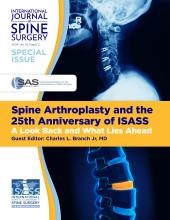ABSTRACT
Background Currently, no authors of existing studies have attempted to classify the signal characteristics of disc herniation on magnetic resonance imaging (MRI) and their temporal relationship to symptoms of lumbar radiculopathy. The purpose of this study was to determine whether the MRI signal characteristics are predictive of acuity of symptoms in patients with lumbar disc herniation (LDH).
Methods A retrospective cohort study was conducted on patients treated at an academic center for LDH from 2015 to 2018. Patients were divided into 2 groups based on symptom duration (acute: ≤6 weeks; or chronic: >4 months). Two independent observers measured T1, T2 signal, and other MRI characteristics at the affected disc level. Univariate analysis was used to compare differences between groups. Multiple logistic regression was used to determine predictors of acuity.
Results Eighty-nine patients were included (33 acute, 56 chronic) with no significant baseline differences between groups. Rater 2 observed a higher proportion of disc bulges in the chronic group (P = .021) and a higher abnormal T1 herniation signal in the acute group (P = .048). Rater 1 found a higher Pfirrmann grade (P = .005) and a higher prevalence of vertebral body spurring (P = .007) in the chronic group. Interobserver agreement for T1 central and herniation signals demonstrated poor to fair agreement, whereas the remainder of the measurements showed moderate to substantial agreement (κ = 0.4–0.8). Multiple logistic regression showed that Pfirrmann Grade 5 (odds ratio = 0.12, 95% confidence interval [0.02, 0.74], P = .022) and anterior/posterior spurring (odds ratio = 0.053 [0.03, 0.85], P = .023) were not associated with acuity.
Conclusions Other than Pfirrmann grade or vertebral body spurring, no MRI characteristics could be reliably identified that correlate with acuity of symptoms.
Level of Evidence 3.
Footnotes
Disclosures and COI: The authors, their immediate family, and any research foundation with which they are affiliated did not receive any financial payments or other benefits from any commercial entity related to the subject of this article. There are no relevant disclosures.
- This manuscript is generously published free of charge by ISASS, the International Society for the Advancement of Spine Surgery. Copyright © 2021 ISASS







